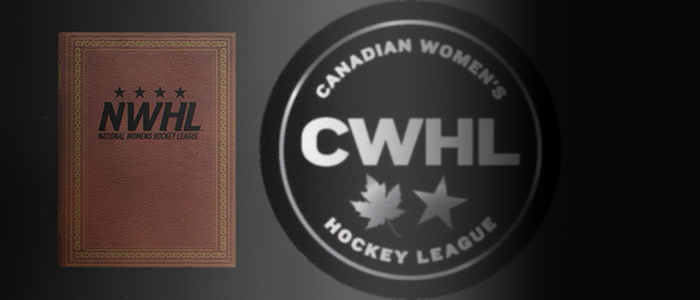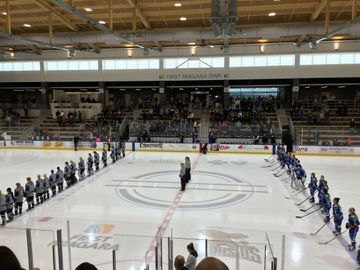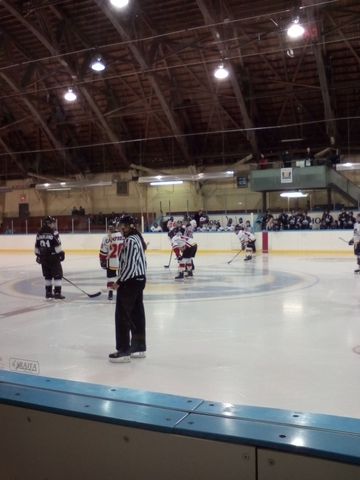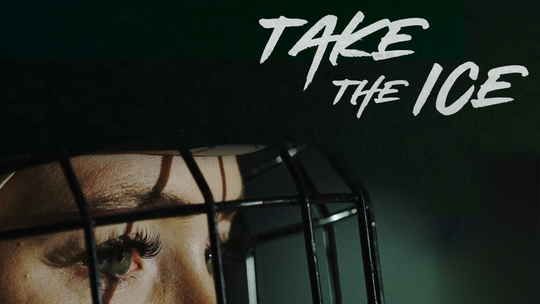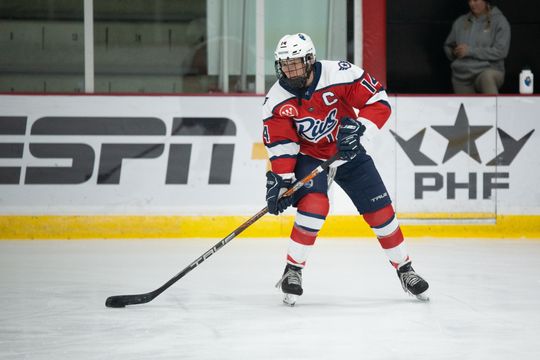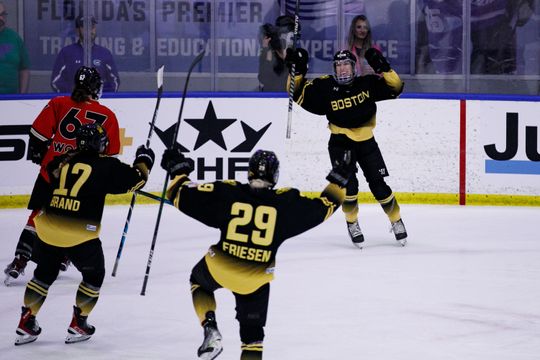This concludes our series on the NWHL and CWHL, and will briefly touch on potential player safety issues going forward.
- Part I: fact sheets and the rise of the NWHL
- Part II: pre-CWHL history and the Outdoor Women's Classic
On Sunday, January 3, the New York Riveters were crushed by the 9-1 Connecticut Whale in what quickly became a much-maligned game by the press. Here's the stat sheet from that game. The shots were fairly even, and through two periods, the game had slowly gotten more contentious as missed calls for minor infractions seemed to pile up for both teams. By the time that Madison Packer was felled in an unfortunate incident along the boards that felt eerily similar to the play that hospitalized the Boston Pride's Denna Laing at the Outdoor Women's Classic, the game was basically over.
Following a seemingly harmless incident in front of Jenny Scrivens' net (who had come in to relieve Nana Fujimoto), Whale forward Micaela Long shoved Riveters captain Ashley Johnston. Despite the fact that the incident devolved into a full line brawl, during which several Riveters left their bench, the only penalties assessed at 13:00 of the third were to Long and Johnston. Johnston got 2 for roughing; meanwhile, Long received 2 for roughing, 5 for charging, and a 10-minute game misconduct.
Kate Cimini at Today's Slapshot wrote a great analysis of the fight itself and what supplementary discipline and better officiating will mean for the NWHL going forward. The short of it is that they have to get this right, because throwing punches is not safe hockey.
The bigger problem has subsequently been the optics of fighting (and even of a contact sport in general) and the variety of misogynistic assumptions that underlie the way fighting in the women's game is perceived and covered by the media. In fact, the line brawl was the first coverage of the Connecticut Whale ever generated by NBC Connecticut, despite the fact that the team is the winningest in the NWHL and has many notable players on its roster.
Hey @NBCConnecticut, the CT Whale are 9-1, but the first time you mention them on air is after a fight? What gives? pic.twitter.com/n5Lc2KClMy
— Ryan Ohanesian (@ryanohan) January 4, 2016Unfortunately, in both men's and women's hockey, the violence of throwing punches at another person's head always comes back around in the context of a discussion of marketability, despite overwhelming evidence that fighting can lead to serious head injuries with long-term impact on both a player's health and life outside of hockey.
Both this game and the Outdoor Women's Classic have seemed to increase the urgency and underline the necessity of having clarity and transparency around player safety. Whether it's an accidental injury or a fight, the risks are, ironically, magnified for a player who plays hockey as a part-time job. The potential for lost income is greater, as are the risks going forward if an injury ultimately ends that player's hockey career or makes it more difficult for them to continue with another job.
That's why it's upsetting to see the national news pick up women's hockey stories because of a serious injury or because of the appearance of girls throwing punches. We remember the "good old days" of the NHL, when fighting was common and every team had an "enforcer" -- you know, those good old days that have led to a rash of accidental deaths and suicides, to drug addictions, and to ongoing mental health issues. As fans, we don't want to see these things happening to NWHL and CWHL players.
But we know from watching hockey that something doesn't necessarily stop because it's forbidden, and that the risks aren't always the first priority when someone has taken a dangerous run at your teammate, for example, and the officials did nothing to help...or when you just get fed up. In the CWHL last year, Monique Lamoureux (then with the Boston Blades) and Jamie Lee Rattray (Brampton Thunder) both served one-game suspensions for dropping the gloves. Without pay, the punishment is far more symbolic. No one was penalized for fighting in the Whale-Riveters brawl this past Saturday, though we know that fighting is a 5-minute major in the NWHL, just as it is in the NHL.
There's been a lot of talk about how the women's game can make itself ready for the big stages, and player safety is paramount. Players have a lot more to lose when they get out on the ice, as compared to their NHL counterparts. Getting player safety right will underpin all the work that has been done to date to legitimize these women as athletes.
- As Kate Cimini pointed out in her previously linked piece, a clear and available rulebook is especially important. Everyone, from a casual fan to a prospective referee to a parent looking to get their child involved in youth hockey, should know exactly what is and is not allowed in professional women's hockey. You can find the CWHL rules on this referees' website from Hockey Alberta -- they mostly use IIHF rules, with differences clearly outlined, and their own OT/shootout procedures. The NWHL rulebook is on their site, but isn't publicly linked anywhere.
- Officiating needs to be better. Bottom line. Both CWHL and NWHL games are often marred by missed calls, which isn't always a huge problem (it happens in every sport, to varying degrees), but games like the one on 1/3/16 in Connecticut underscore a need for experienced officiating. The Whale's next game featured much tighter officiating, and the gameplay benefited immensely.
- Players' unions should strive to be places where players can go with concerns about anything that might impact their lives or their play, and they should be involved in the disciplinary process (as we've seen from the NWHL).
- Disciplinary proceedings should be public, which is something that we've also already seen from the NWHL. The CWHL has not thus far made a habit of announcing its suspensions or other supplementary discipline.
- Surpass current standards every day. Don't bury criticism. Demand excellence from playing facilities. Laing's injury raised concerns about the ice at Gillette Stadium, and contradictory accounts have arisen about whether that ice was safe to skate on. In the future, those concerns should be taken more seriously -- even in the face of "making history."
Of course, all of this is far easier said than done. Getting experienced officials may take time, and so may nailing down the best ways to handle supplementary discipline. The one-game suspension for Molly Engstrom after repeatedly checking Meghan Duggan in the head was the NWHL's first go-around, and many thought the suspension was light when considering the viciousness of the play. It's a short season, though. So far, it's gone by like a blur -- a brightly colored, surprising, and strange blur.
There haven't been any fights or supplementary discipline (that I know of) in the CWHL yet this season. The NWHL issued another round of supplementary discipline following the Riveters-Whale game, suspending both Connecticut's Micaela Long for her late hit on Johnston and New York's Elena Orlando for leaving her bench to throw punches. Each player was kept out of the lineup for one game and forfeited her salary for that game.
After Denna Laing's injury in the Outdoor Women's Classic, both the NWHL and CWHL have issued public statements clarifying that they carry full medical and injury insurance for their players. It's also important to note that any player registered with either USA Hockey or Hockey Canada receives injury benefits and may file a claim for assistance with expenses that stem from an injury sustained in any game that is sanctioned by their organizing body.
Laing suffered a severe spinal cord injury during the game and remains partially paralyzed -- though she seems to be in good spirits and is excited to have made history at the Outdoor Women's Classic. Madison Packer should also return to the ice soon.
After both professional leagues have had their playoffs, the Victory Press plans to provide a comprehensive review of the culture and climate that surrounds fighting in women's hockey. In the meantime, we wish all teams the best of luck as they prepare for their all-star breaks and enter the final stretches of their seasons. This has been a very big year for women's hockey that will be something to savor -- while also wishing all players injured this year a speedy recovery, and trying our damnedest to make it safer.
